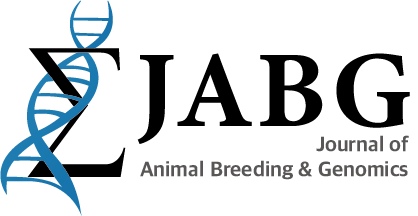Abstract
To date, a number of local duck breeds has been widely raised across Java island of Indonesia, namely Mojosari, Magelang, Rambon, and Turi. In order to evaluate the genetic diversity among them, 22 microsatellite markers were used to genotype of 120 individuals (30 individuals per population). Such indicators, including number of alleles (Na), observed heterozigosity (Ho), expected heterozigosity (He), polymorphism information content (PIC), and Wright’s F-statistics (FIT, FIS, FST) were analyzed. A total of 139 alleles were detected in all loci, ranging from 3 (AMU123, CAUD128, CAUD009) to 21 (CAUD048). The mean value of Ho, He, and PIC were 0.465, 0.580, 0.524, respectively, indicating relatively medium genetic diversity among populations. Only 8 loci were not in accordance to Hardy Weinberg equilibrium (P < 0.01). Among the four populations, the global heterozigosity deficit (FIT) was 0,197, global inbreeding of individuals within population (FIS) was 0.112, and population differentiation index (FST) was 0.093. In conclusion, relatively medium genetic diversity and differentiation among populations were successfully estimated using 22 microsatellite markers. The considerable genetic diversity among populations will allow us for future breeding improvement, as well as conservation strategies.
Acknowledgements
This work represented an international research collaboration between Universitas Gadjah Mada, Yogyakarta, Indonesia and Chungnam National University, Daejeon, South Korea, supported by the Indonesian Directorate General of Higher Education (DIKTI) with contract No. 2262/UN1-P.III/DIT-LIT/LT/2017. We also thank to the Agricultural and Livestock Bureau of Cirebon, Magelang, Ogan Ilir, Pesisir Selatan, Tanah Datar, and Livestock Breeding Center (BPTU-HPT) Pelaihari for assisting in the collection of blood samples from breeding flocks.
Figures & Tables

Distribution of four local duck breeds across Java island.


